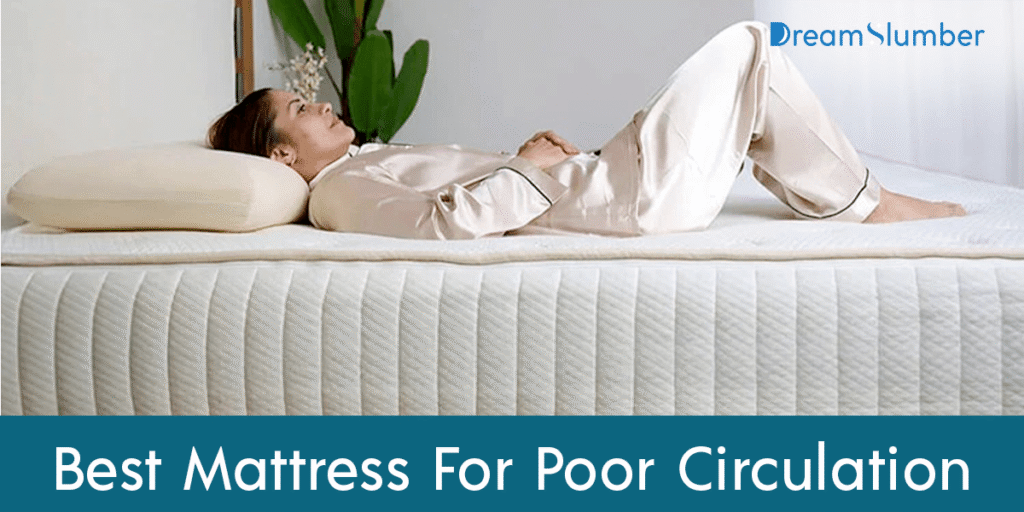When you purchase through our links, we may earn a commission at no extra cost to you. As an Amazon Associate, DreamSlumber earns from qualifying purchases. Learn more.
Poor blood circulation is a common issue faced by millions, with symptoms such as numbness, tingling, or cold extremities during sleep. If you are one of them, you may also experience problems like peripheral artery disease (PAD) and edema. In the U.S., 6.5 million people aged over 40 suffer from the symptoms of such chronic conditions. These numbers can be reduced by using the best mattress for poor circulation and adopting lifestyle changes, such as learning how to improve circulation in your legs while sleeping.
The right mattress can relieve pressure points, support your body without trapping it, and align your spine so that blood can move freely. So, scroll down for a curated look at some of the top mattresses in 2025. Here, you’ll find detailed comparisons and helpful tips on how to improve circulation while sleeping.
Top Mattresses for Poor Circulation in 2025
Circulation and sleep are deeply connected when it comes to maintaining your optimum health. A restful sleep ensures that you get proper delivery of oxygen and nutrients throughout the body. And to target this quality sleep, you need a supportive sleep environment that includes ergonomic mattresses and bed frames with adjustable features.
Let us have a look at a detailed comparison of the seven top available mattresses that improve blood circulation with their user-friendly design and premium features:
1. Layla Memory Foam Mattress
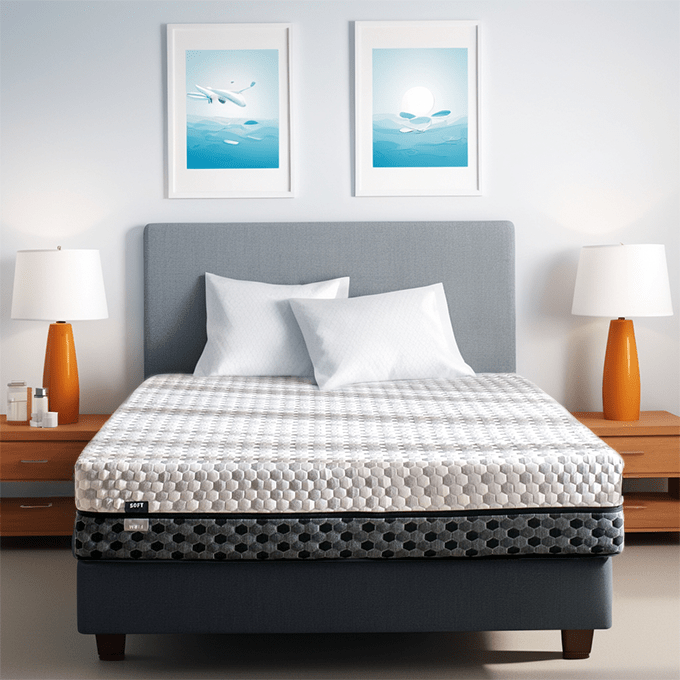
If you’re searching for the best mattress for poor circulation, the Layla Memory Foam Mattress is worth a close look. It gives two different feels in one bed, a softer contouring side that eases pressure at the hips and shoulders, and a firmer side that lifts and supports the spine. The flippable design helps you fine-tune the balance between pressure relief and support without buying two mattresses.
Layla’s copper-infused memory foam responds slowly enough to cradle sensitive areas while still offering enough pushback to stop you from sinking too deep. This helps reduce local nerve compression and the numbness some sleepers feel.
Other than the feel, the Layla mattress features cooling and durability. The copper infusion improves thermal conductivity compared with older memory foams and is antimicrobial. The mattress is shipped in a box and easily rolls out at home. This makes testing different positions for circulation easy during the manufacturer’s 120-night trial.
If you have leg or shoulder circulation issues, start on the softer side to reduce peak pressure, then flip to the firmer side if you need more spinal alignment. This versatility makes Layla a practical memory foam mattress for poor circulation without committing to a single firmness.
Pros:
- Two firmness options in one mattress.
- Strong pressure relief on the soft side for side sleepers.
- Good motion isolation, useful for partners with different sleep schedules.
- Easy home trial (120 nights) to test real-world circulation benefits.
Skip If:
- You prefer a very bouncy or ultra-firm coil feel (hybrids/innerspring).
- You need an explicitly natural or organic latex mattress for circulation alternative.
- You want immediate and high-level edge support for sitting on the bed’s rim.
2. Pure Green Organic Latex Mattress
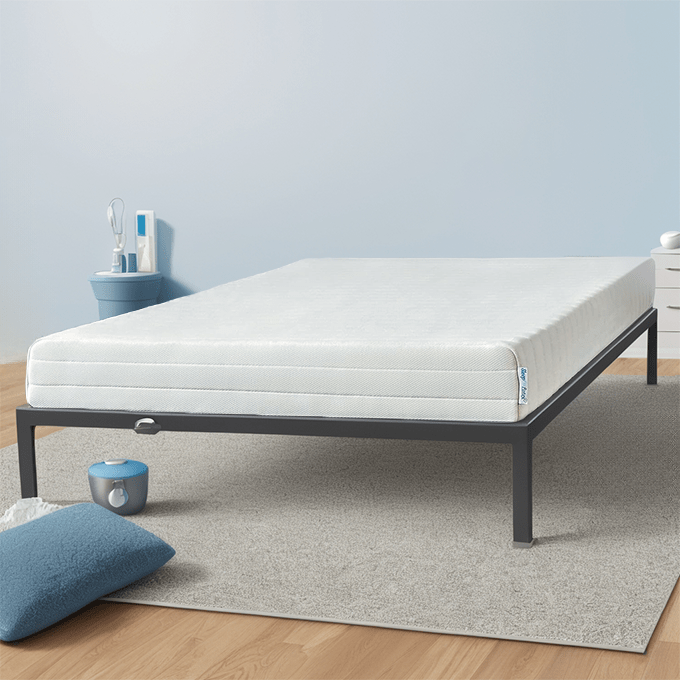
The Pure Green Organic Latex Mattress provides a naturally responsive surface that keeps blood moving. Its natural latex yields under load and then springs back, which reduces pressure peaks while keeping the spine aligned. This combination helps the body avoid sustained compression at contact points. These ease poor circulation symptoms like numbness and pins-and-needles. Moreover, latex is cooler than dense foams, supporting healthy skin perfusion overnight, and suits sleepers who change positions.
Pure Green focuses on organic certifications (GOLS for latex, GOTS for fabrics) and durable construction. This appeals to sleepers who want a hygienic and long-lasting sleep surface. The mattress comes in firm or medium materials, so you can choose a firmness level that keeps the hips from sinking.
For circulatory issues centered in the legs, latex’s responsiveness helps maintain gentle support under the thighs and calves while allowing your shoulders and hips to settle in. This makes it one of the most effective orthopedic mattresses for circulation. Many sellers and specialty retailers offer trial windows (varies by retailer), letting you verify whether the latex feel improves your symptoms.
Pros:
- Natural and breathable latex reduces heat retention and supports circulation.
- Fast response prevents deep sinkage while still relieving pressure.
- Strong durability, as latex often outlasts synthetic foam cores.
- Certified organic materials for buyers prioritizing non-toxic sleep surfaces.
Skip If:
- You want the deep contouring hug of slow memory foam.
- You need a very soft feel for severe shoulder pressure.
- Budget is tight, as natural latex is pricier upfront than polyfoam options.
3. Natural Escape Organic Mattress
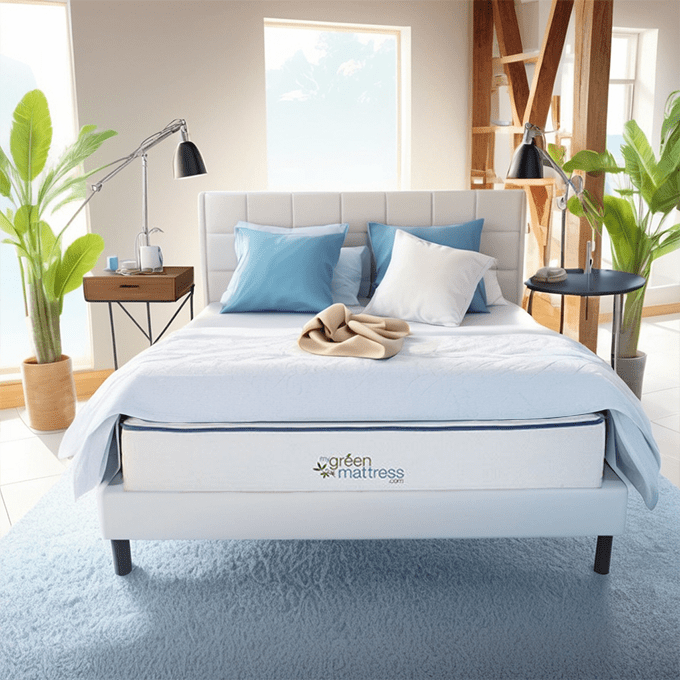
If you want a sleep surface that helps relieve pressure while staying breathable, the Natural Escape Organic Mattress balances latex comfort with supportive pocketed coils. The latex top conforms to soften shoulders and hips without letting you sink or pinching your veins. The zoned coil core lifts the hips to keep the spine neutral, useful for anyone who wants to easecirculation symptoms at night.
This mattress for poor circulation and back pain uses certified organic materials (GOLS for latex, GOTS for fabrics). It avoids polyfoam and toxic flame-retardant chemicals, which appeals to people who want a cleaner sleep environment that gives pressure relief.
The Natural Escape mattress is durable and breathable. The wool layer adds natural moisture control and temperature regulation, which makes it an ideal mattress for varicose veins. This bed comes in the medium-firm range, making it a solid pick for back sleepers and many side sleepers who need both pressure relief and lift under the hips.
If leg circulation is a primary concern, the responsive latex and coil support help avoid deep hip sinkage that can increase local pressure on nerves and vessels. Trial policies and terms vary by retailer, so check current trial/warranty details when you buy.
Pros:
- Natural and breathable materials reduce heat retention and support healthy skin perfusion.
- Zoned coils give extra lumbar support to protect spinal alignment.
- The latex top combines pressure relief with quick response for changing positions.
Skip If:
- You want a plush, slow-hug memory foam feel (latex is more responsive).
- Budget is tight, as organic latex/coils cost more up front.
- You need an ultra-soft surface for very light sleepers (<130 lb).
4. Amerisleep AS3 Mattress
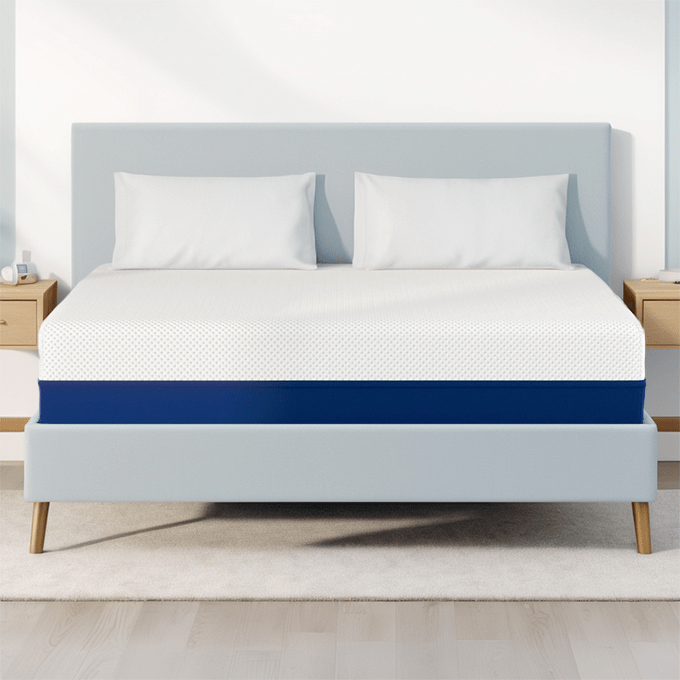
The Amerisleep AS3 is one of the most consistent choices for sleepers looking to manage poor circulation symptoms through better pressure distribution and spinal alignment. Its comfort system uses a contouring memory foam that eases pressure at the shoulders and hips. Additionally, its HIVE® zoned support provides targeted resistance under the hips and lower back to keep the spine neutral.
Its overall construction reduces local compression of soft tissue and nerves, which often underlie nighttime numbness or tingling. AS3 is a comfortable medium-firm mattress that suits many body types and sleeping positions, making it the best mattress for diabetic circulation.
Amerisleep’s foams are designed to give pressure relief without an overly slow sink that traps heat. The AS3 performs well on alignment and support. These features make it an ideal memory foam mattress for poor circulation when you want contouring and enough lift to keep circulation steady.
The company’s 100-night trial gives you time to test whether the mattress eases your symptoms, and its warranty protects against early material faults. If you prefer a hybrid coil core or natural latex, Amerisleep also offers hybrid options in its lineup.
Pros:
- Strong balance of pressure relief and spinal support for many sleepers.
- Medium feel works well for back and side sleepers who want contour without deep sink.
- Well-reviewed by mattress testers for comfort and durability.
- Cooling cover and breathable Bio-Pur® foam help regulate temperature for a cooler sleep experience.
Skip If:
- You need a fast and bouncy coil response (hybrids might suit better).
- You need immediate edge support for heavy sitting on the bed rim.
5. DreamCloud Luxe Hybrid
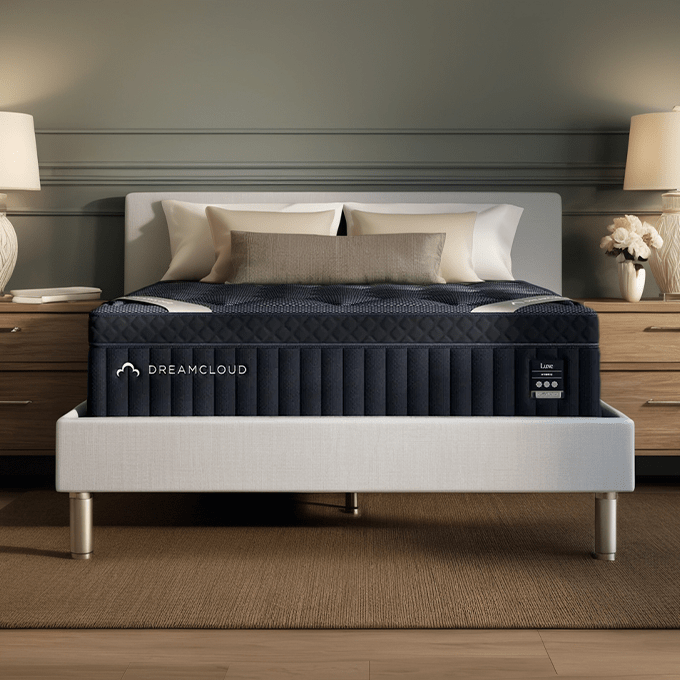
The DreamCloud Luxe Hybrid blends plush and pressure-relieving foam with a responsive pocketed coil system to deliver both contour and lift. These features help relieve pressure points while keeping the spine aligned. The memory foam layers soften contact areas at the shoulders and hips, easing poor circulation symptoms in those hotspots. Its coil core returns the support needed to prevent sinkage that can restrict blood flow in the legs and hips.
DreamCloud adds cooling fibers and phase-change materials in the top layers to help skin perfusion and comfort overnight. This is useful because overheating can alter peripheral circulation. The Luxe is a medium to medium-firm hybrid that scores well on pressure relief, edge support, and overall sleep quality.
For sleepers who want a luxury feel but need circulation benefits, the Luxe Hybrid’s zoned support and breathable hybrid build make it a strong hybrid mattress for poor circulation. The long trial window gives plenty of real-world nights to confirm improvement in numbness or swelling, and the company’s warranty and white-glove delivery options (when offered) simplify setup.
If you prefer a firmer and fully natural latex option, compare this hybrid against mattresses with organic latex comfort layers. This will help you find the right trade-off between contour and responsiveness.
Pros:
- Luxury pressure relief with zoned coil support for spinal alignment.
- Cooling the top layers helps regulate night temperature and skin perfusion.
- Good edge support and motion isolation for couples.
Skip If:
- You want a pure latex or fully organic build (hybrid uses foam layers).
- You need the lowest price point. Luxe is a premium hybrid.
- You prefer an extremely soft, slow memory-foam hug.
6. Nectar Luxe 14” Queen Mattress

The Nectar Luxe 14” emphasizes gentle contouring while managing heat. These two things help reduce symptoms of poor circulation, such as numbness or pins-and-needles.
The Nectar Luxe’s layered memory-foam build lets your shoulders and hips sink just enough to lower pressure points. Its deeper support layers keep your spine aligned, so blood flow doesn’t get pinched by misalignment. These features make it the best mattress for leg circulation when you want cushioning without losing lift.
Nectar adds extra cooling fibers and breathable covers to the Luxe model to improve overnight comfort and skin perfusion, because overheating can constrict peripheral circulation. The brand gives a trial window (365 nights) so you can test whether its firmness level for circulation issues and pressure relief reduces numbness over the nights of sleep.
If your circulation issues respond to softer, more contouring surfaces, the Luxe will likely feel soothing. Just be mindful that very heavy sinkage can sometimes reduce the lift under the hips for obese sleepers.
Pros:
- Deep and plush pressure relief that eases shoulder and hip hotspots.
- Strong cooling features for better overnight comfort and circulation.
- Long trial window to verify real-world benefits for symptoms.
Skip If:
- You need a very firm, highly lifted surface to avoid any hip sinkage.
- You prefer a hybrid coil system or a natural latex mattress for circulation alternatives.
- Quick edge support is a top priority for heavy users who sit frequently on the bed rim.
7. Leesa Original Hybrid 11″ Mattress
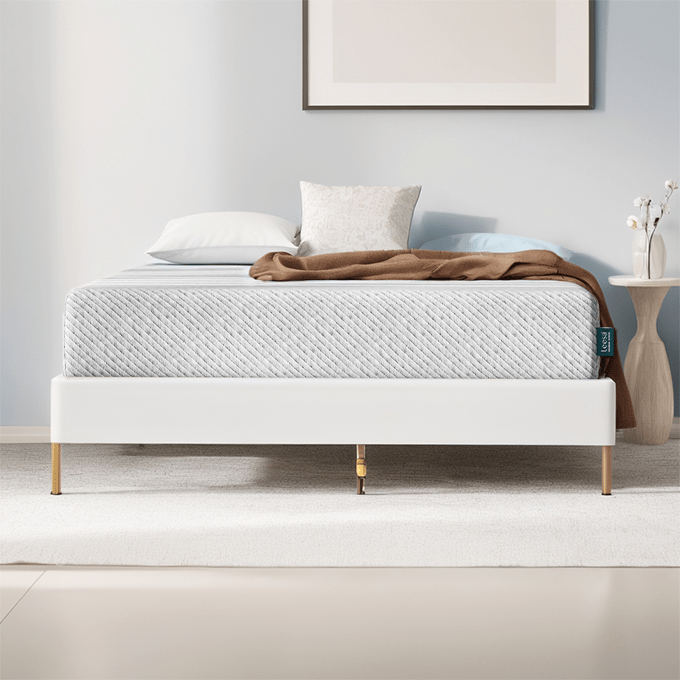
The Leesa Original Hybrid 11″ blends soft comfort layers with coils that push back under the hips. This helps maintain spinal neutrality and steady blood flow, a key factor when selecting the best mattress for poor circulation.
The hybrid build gives you pressure relief at contact points while preventing excessive sinkage that can trap limbs and reduce circulation. For many back sleepers and combination sleepers, this balanced feel keeps blood flowing without compromising the body’s natural contour.
Hybrid designs like Leesa’s also promote airflow through the coil core, which helps avoid overheating at night. The Original Hybrid gives a medium-firm feel, making it a good choice for people who need both cushioning and support.
Leesa’s coil system also tends to offer better edge support than pure foam beds, useful if you sit on the bed or sleep near the edge. The 100-night trial gives you time to feel whether the mattress eases leg numbness or swelling in your regular sleep positions.
Pros:
- Hybrid lift with targeted pressure relief, good for hybrid mattresses for circulation needs.
- Better airflow than all-foam beds, supporting overnight skin perfusion.
- Stable, medium-firm feel that suits many sleepers and body types
Skip If:
- You prefer an all-foam memory foam mattress for poor circulation that hugs more deeply.
- You need the deepest possible contouring for severe shoulder pressure.
Comparison Table For The Best Mattress For Poor Circulation 2025
| Mattress | Type | Firmness | Key Features | Circulation Score |
| Layla Memory Foam Mattress | Memory foam (flippable) | Soft/Firm (flippable) | – Flippable firmness – Copper-infused memory foam – Good pressure relief and – motion isolation 120-night trial | 8/10 |
| Pure Green Organic Latex Mattress | Natural latex | Medium (also Firm option) | – GOLS-certified organic latex – Breathable and strong durability – Organic GOTS quilted cover – Good pressure distribution | 9/10 |
| Natural Escape Organic Mattress (My Green Mattress) | Latex and Zoned pocketed coils (hybrid) | Medium-firm (6-7) | – 3″ organic Dunlop latex comfort layer – Up to 1,462 pocketed coils with 7-zone lumbar support – GOTS cotton/wool cover – Highly breathable and supportive | 9/10 |
| Amerisleep AS3 | Memory foam (Bio-Pur and zoned foam) | Medium (6) | – Bio-Pur® memory foam comfort layer – HIVE® zoned support for lumbar lift – Balanced pressure relief and responsiveness – 100-night trial | 8/10 |
| DreamCloud Luxe Hybrid | Hybrid (foam and pocketed coils) | Medium/Medium-firm | – 7-layer hybrid with CloudQuilt+™ euro top – Tri-zone pocketed coils for targeted support – Cooling fibers/phase change material – 365-night trial | 8/10 |
| Nectar Luxe 14” | Memory foam (luxury layered) | Medium-firm (5.5-6) | – 5-layer memory foam construction – Enhanced cooling fibers and breathable cover – Strong contouring for pressure relief – 365-night trial | 7.5/10 |
| Leesa Original Hybrid 11″ | Hybrid (foam and pocketed coils) | Medium-firm (6) | – Comfort foams over 8″ pocketed coil core – Zoned coil layout for lumbar lift – Breathable knit cover – Good edge support and airflow | 8/10 |
Why Mattress Choice Matters for Circulation?
A mattress that creates pressure points or allows parts of the body to sink too far can squeeze small blood vessels and nerves. This may worsen common symptoms like numbness, tingling, or cold hands and feet. A National Library of Medicine research shows that improper sleep posture often results in waking up with musculoskeletal pain and spinal complaints. These persistent alignment problems can aggravate circulation by increasing local pressure on soft tissues and nerves.
Poor posture -> more pressure on nerves and tissue -> impaired blood flow in affected areas.
Sleep experts and physical therapists recommend a few practical tips that you can adopt in the bedroom. As Dr. Devon Hoffman puts it, “A supportive mattress and strategically placed pillows can aid in aligning and supporting your spine.” This reduces pressure points, improves comfort, and helps the body keep blood moving during sleep.
That’s why pressure relief mattresses and designs that redistribute weight help by reducing peak pressure and lowering the risk of tissue compression. These mattresses also maintain circulation to the skin and deeper tissues. This same mechanism is used clinically to prevent pressure injuries.
A mattress that spreads load evenly also makes it easier to adopt the best sleeping position for circulation (usually back or side with spinal neutrality). This is another easy way to improve circulation while you sleep.

Types of Mattresses Best for Poor Circulation
Before investing in a new ergonomic mattress, first understand how different materials and designs work. Their science-backed construction helps in moving pressure away from sensitive areas and keeping your spine in a neutral line. To make a smart decision, let us look at the features of various mattress materials and their examples:
Memory Foam Mattresses
- Benefits: Memory foam conforms to the body, reducing pressure on hips and shoulders and smoothing out high-pressure spots. This makes it easier to sleep without numbness or pins-and-needles.
- Example: Layla (flippable memory foam) and Amerisleep AS3 (medium memory foam).
- Why It Helps: Memory foams redistribute weight and lower peak pressure, which reduces nerve compression and helps sustain blood flow to the skin and muscles. Clinical reviews of foam surfaces show they can prevent pressure injuries as they give evenly distributed support.
Latex Mattresses
- Benefits: Natural latex feels responsive and buoyant. It supports spinal alignment while staying breathable and durable. It is best for people who change positions during the night.
- Examples: Pure Green Organic Latex Mattress and Natural Escape Organic Mattress (My Green Mattress)
- Why It Helps: Research found that latex mattresses reduce peak body pressure and create a more even pressure map than some polyurethane foams. This lower peak pressure helps avoid blood flow restriction in contact points.
Hybrid Mattresses
- Benefits: Hybrids blend foam or latex comfort layers with pocketed coils to balance pressure relief and spinal support. Its breathability factors provide extra airflow for cooler sleep.
- Example: DreamCloud Luxe Hybrid and Leesa Original Hybrid 11″
- Why It Helps: The foam or latex top provides cushioning where you need it, while coils keep the spine aligned and prevent you from sinking too deep. Together, they ease pressure and help blood reach your limbs.
Adjustable Beds

- Adjustable Bed Benefits for Circulation: These beds let you raise the head or legs and find a zero-gravity position that feels weightless. This semi-Fowler position can reduce pressure on the heart and improve venous return from the legs.
- Example: Amerisleep AS3 and Layla Memory Foam Mattress
- Why It Helps: Adjustable beds for circulation problems use leg elevation to reduce swelling and improve circulation in patients with peripheral edema. In fact, scientific studies show these positional changes can lower leg swelling and aid fluid return. Elevating the legs about 6”-12” (or using a zero-gravity preset) can help reduce ankle and foot swelling and keep blood flowing during rest.
Comparison Table: Mattress Types
| Type | Pressure Relief | Support | Breathability | Best For |
| Memory Foam | High | Medium | Moderate | Side sleepers Pressure relief |
| Latex | High | High | High | Combination sleepers Eco-conscious |
| Hybrid | High | High | High | Back sleepers Couples |
| Adjustable Bed | Varies | Varies | Varies | Leg elevation Customizable positions |
Key Features to Look for in a Mattress for Poor Circulation
While adding a blood circulation-friendly mattress to your cart, looking at popular brand names is not enough. Instead, evaluate your choices based on how these mattresses handle three things that directly affect blood flow: pressure, support, and temperature. Let us read about them in detail:
Pressure Relief
A mattress that redistributes weight lessens local tissue compression and lowers the risk of nerve and vessel constriction that causes numbness or tingling. Choose beds with soft and contouring top layers that cradle shoulders and hips. Its support core must prevent you from deep sinkage. Using mattress toppers for circulation (like Amerisleep’s Lift Topper) can also test pressure relief before committing to a new mattress.
Examples:
- The Layla Memory Foam Mattress and Nectar Luxe 14″ give deep contouring for hotspot relief (good for side sleepers).
- Pure Green Organic Latex Mattress and Natural Escape use latex to even out pressure with a faster response.
Support
A sturdy and firm support keeps your spine aligned, so soft tissues do not bear uneven loads that can pinch vessels. Research by PubMed Central shows medium-firm mattresses often deliver the best balance of comfort and spinal alignment across sleepers. This helps reduce strain that can worsen circulation. Look for zoned support or targeted transition layers that lift the hips while cushioning shoulders.
Examples:
- The Amerisleep AS3 uses a HIVE® zoned layer for targeted lumbar lift.
- Hybrids like the DreamCloud Luxe Hybrid and Leesa Original Hybrid pair comfort foams with pocketed coils.
Breathability
Night-time overheating can affect peripheral circulation. Therefore, breathable constructions and cooling layers help the skin stay comfortable and maintain normal blood flow. Go for hybrid coil cores, ventilated latex, gel-infused, or open-cell foams to improve airflow. Use breathable covers (organic cotton or Tencel) for the best surface temperature control.
Examples:
- DreamCloud Luxe Hybrid and hybrid designs like Leesa offer better airflow through coils.
- Pure Green and Natural Escape rely on latex and natural covers to stay cool and breathable.
- Layla and Nectar add cooling fibers or copper-infused layers to manage heat while still offering several benefits as the best pressure relief mattresses.
Adjustability
An adjustable bed with leg elevation presets can improve venous return and reduce ankle or foot swelling for people with peripheral edema or varicose veins. Reputable health sources note that leg elevation is an effective measure to help blood flow back toward the heart and lower pressure in leg veins. If you have leg swelling, test the mattress on an adjustable base or try temporary elevation during your trial. To see if an adjustable base is right for you, check out our comparison of an adjustable bed vs a regular bed.
Examples:
- Use a power base with zero-gravity or slightly elevated leg presets alongside a mattress like DreamCloud or Amerisleep.
Checklist for In-store or Home Trial
- Pressure Test: Lie on your side and on your back for 10-15 minutes. Do shoulders or hips feel too restricted? If yes, try a mattress with more contouring or add a topper.
- Spinal Check: While lying on your back, ask whether your lower back feels supported and does not get pushed upward.
- Heat Check: Place your hand on the surface after 10 minutes. Does it trap heat? If so, opt for hybrid or latex builds with breathable covers.
- Edge and Lift: Sit on the bed’s edge. Does it hold you up without collapsing? Good edge support helps with getting in and out without compressing leg circulation.
- Trial and Trial-Specific Test: Use the sleep trial to test real nights. Track your symptoms of numbing or swelling for at least 30-90 nights and try both sides/positions if the mattress is flippable.
- Try Elevation: If swelling is an issue, test the mattress on an adjustable base or lie with legs elevated for 15 to 30 minutes to feel changes in comfort.
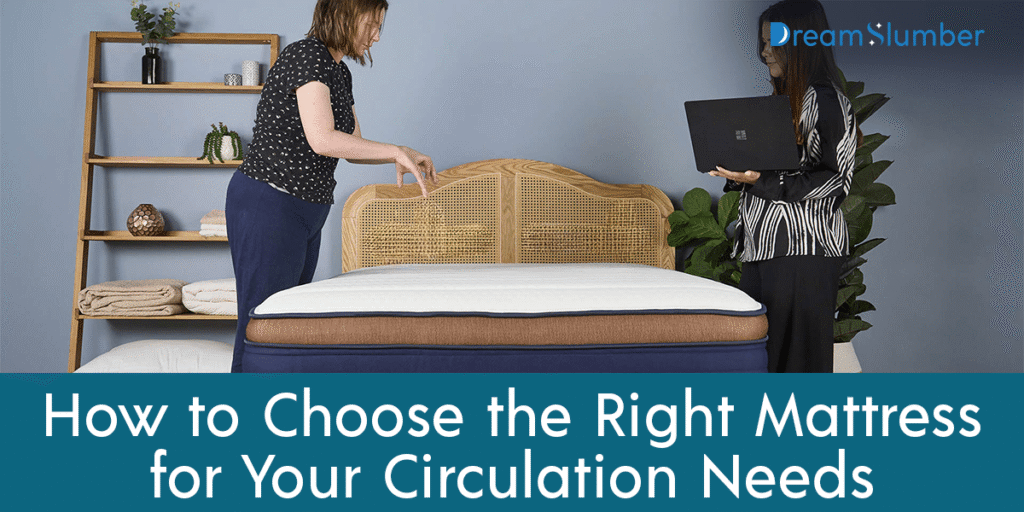
How to Choose the Right Mattress for Your Circulation Needs
There’s no golden rule or standard option to select the best mattress for poor circulation. Your mattress shopping decision should depend on your health-specific needs, sleep habits, and comfort preferences. Therefore, invest in the one that aids your arterial health with its ideal firmness and scientific build. Here is a detailed step-by-step guide on how to choose a mattress for circulation issues:
1. Sleeping Position
While choosing the mattress, understand your sleep and comfort preferences:
- If you are a back sleeper, a medium-firm mattress gives good spinal support without making your hips sink too much.
- For side sleepers, a soft surface that contours to the body and lowers pressure on the shoulders and hips works best.
- Stomach sleepers should avoid overly soft beds to prevent lumbar strain and poor spinal alignment.
2. Firmness Level
The ideal firmness of the mattress depends on the weight of the sleeper, such as:
- Sleepers who weigh less than 130 lbs must choose softer to medium mattresses (rated 3-6).
- For average sleepers who weigh between 130 and 230 lb, a medium to medium-firm (rated 5-7) mattress will suit you well.
- Obese sleepers with bodyweight measuring greater than 230 lb must choose medium-firm to firm (rated6-8) for durable support.
3. Materials and Construction
If you are exploring latex vs memory foam for circulation or other hybrid options, go for the one that provides contouring with enough lift to keep your spine neutral:
- Memory foam: Great for pressure relief and for side sleepers who need contouring.
- Latex: Responsive and breathable. It resists deep sinkage while still relieving pressure.
- Hybrid: Combines coils and comfort layers for airflow, support, and pressure relief.
4. Trial Periods and Warranties
Pick brands that offer long sleep trials and warranties so you can test whether a mattress actually helps your poor circulation symptoms. For example, Amerisleep offers a 100-night sleep trial, and their mattresses carry a 20-year limited warranty. This gives buyers adequate time to decide. Many reputable brands offer 100+ night trials.
5. Budget
Budget is an important factor when going for your final mattress selection:
- For budget-minded shoppers, look for tested models with reliable 100-night trials.
- For premium options, opt for well-built hybrids and latex models, designed for pressure relief and long-term use.
Additional Tips for Improving Circulation During Sleep
While improving your sleep environment can be a game-changer for your circulatory system and overall wellness, this is not enough. You must make small lifestyle changes, from maintaining bedtime rituals to better eating habits, to get the best health benefits.
Let us read more about such evidence-backed tips on how to optimize your sleep environment, diet, and exercise for better circulation:
Sleep Positions
Sleep on your back with your legs slightly elevated or on your side with a pillow between the knees to keep your spine neutral. Elevating the legs helps venous return from the feet and ankles, which can reduce swelling. Many therapists use leg elevation as a standard practice to relieve peripheral edema. To keep your pelvis aligned and reduce pressure on your hips and lower back, use a wedge pillow between your knees.
Pillows and Bedding
Adding a pressure-relieving topper or a supportive knee pillow can help open up your blood vessels, aiding the blood flow. For example, the Amerisleep Lift Topper is designed to reduce pressure while keeping the sleep surface breathable. To choose the best pillows for poor circulation, look for their firmness and a wedge shape.
Regular Excercise
Five minutes of gentle ankle pumps (point and flex the foot) or light calf stretches before sleep activates the calf muscles. This helps push blood back toward the heart. Clinical studies show ankle-pump exercises and regular calf stretching improve venous return and calf-pump function. Try 60 repetitions of ankle pumps per minute for 2-3 minutes. You can also do two to three gentle calf stretches for 20-30 seconds each.
Hydration and Diet
Drinking 2-3 litres of water daily helps your heart pump blood more easily and is one of the best natural ways to improve circulation during sleep. A balanced diet rich in antioxidants (leafy greens, berries, citrus, nuts, dark chocolate) supports healthy blood vessels and flow. Dietary antioxidants lead to better endothelial function, so including whole foods in the diet is an effective strategy.
Bedtime Routines
Try a 5-minute warm foot soak or a brief leg massage to relax muscles before doing ankle pumps. Avoid heavy meals and alcohol right before bed, since these can worsen swelling for some people. Keep bedroom temperature comfortable and maintain your sleep hygiene for poor circulation by choosing breathable bedding for better circulation.

Frequently Asked Questions
Can a bad mattress cause poor circulation?
Yes, a soft or very firm mattress can pinch your veins or blood vessels while sleeping. These may restrict the blood flow and may cause excessive numbness or cold hands/feet. A mattress with poor support may cause discomfort to your spine, impairing the circulation even more. That is why it is recommended to replace your mattress every years of use with one that distributes your weight and aligns the spine.
What is the best type of mattress for circulation problems?
To choose the best type of mattress, look for features that help keep your spine neutral when you sleep. For this, choose among memory foam, latex, or hybrid options and invest in an adjustable bed frame to relieve your pressure points. Go for a medium-firm mattress that gives the optimal support to your body for a restful sleep.
How does an adjustable bed help with circulation?
An adjustable bed for poor circulation comes with presets to lift your legs and torso. This elevation directs the blood flow away from swollen areas and back toward the heart. Its in-built zero gravity position for circulation reduces fluid pooling in the ankles and eases pressure on veins. It provides instant relief after a long day and makes sleeping more comfortable for people with varicose veins or edema.
Are memory foam mattresses good for poor circulation?
Yes, memory foam mattresses take the shape of your body and distribute weight evenly. This lowers pressure on shoulders, hips, and other contact points, which can stop local compression that interrupts blood flow. For best results, choose memory foams with cooling features (gel or breathable covers) so they do not trap heat and constrict blood vessels.
What role does mattress firmness play in circulation?
A mattress that’s too firm creates sharp pressure points and can limit blood flow. On the other hand, the one that’s too soft lets your body sink and lose proper alignment. A medium-firm mattress keeps the spine in line and spreads your bodyweight evenly. This feature helps maintain steady blood flow through the night.
Can sleeping on a waterbed improve circulation?
Yes, it can, as a waterbed conforms to your shape and reduces pressure on the veins, which may ease symptoms for some sleepers. For immobile sleepers, heated waterbeds improve local blood circulation and reduce the painful symptoms. These are effective options, but they need regular maintenance.
How often should I replace my mattress if I have circulation issues?
You must replace your mattress if it is sagging, gives an uneven feel, or you are noticing symptoms of numbness with uncomfortable sleep. Most mattresses are designed to last you for 7 to 10 years. However, their durability varies with the type of materials used. Memory foam lasts 7-10 years, hybrids and innersprings about 7-8 years, and well-kept waterbeds sometimes 10-15 years.
Conclusion: Prioritizing Sleep and Circulation
Your mattress plays a major role in improving your blood circulation and giving you a restorative sleep that your body needs each day. To find the best mattress for poor circulation, look for one that comes with pressure relief features, spinal alignment, and breathability. Mattresses like the Pure Green Organic Latex Mattress, Natural Escape Organic Mattress, or Amerisleep AS3 focus on improving blood flow.
You must also invest in an adjustable bed frame to get the optimal sleep support, along with a daily bedtime routine and a nutrient-rich diet. If the symptoms of swelling or pain persist, consult your clinician for the best recommendations. Say goodbye to sleepless nights and uncomfortable mornings. Transform your sleep sanctuary into the one that supports your wellness goals with the right mattress today!

